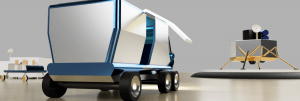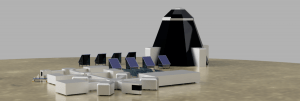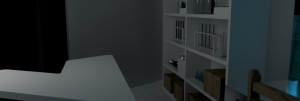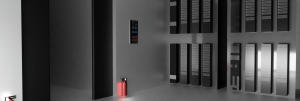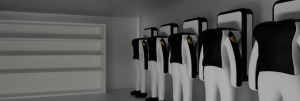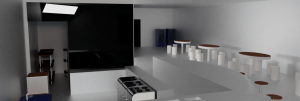Moon Camp Pioneers Gallery 2020-2021
In Moon Camp Pioneers each team’s mission is to 3D design a complete Moon Camp using Fusion 360. They also have to explain how they will use local resources, protect astronauts from the dangerous of space and describe the living and working facilities.
Team: Atlas
Colegiul Național „Petru Rareș” Piatra-Neamț Romania 16
External viewer for 3d project
|
Project description
Since the beginning of life, people have always been fascinated by the Moon. Whether it meant using our lunar neighbour as a calendar in the sky or sketching it on canvas, humans have held an enduring interest towards the moon. In 1969, when Neil Armstrong took “the giant leap” for humankind, he let us dream of making the moon home. As our understanding of the satellite has grown, more and more challenges arose about its colonization. In spite of the extremely hostile environment, we envisioned a sustainable lunar base for exploration and research located at the South Pole of the moon. Consisting of a research unit, a dispatch centre, a server room (for storing information, storing valuable info and ensuring a telecommunication route to Earth), four sleeping rooms, one dining unit, a gym and relaxation centre, it would host 24 people who would depend on two oxygen farms and recycled water. |
|||
|
Where do you want to build your Moon Camp?
We chose moon’s South Pole as the location of our base for its many resources. There is ice, which can be melted to obtain possibly drinkable water. This region provides us with metals as Aluminium, Calcium, Magnesium, useful in experiments and even base construction as well as Oxygen and Hydrogen are known to be present. The lunar South Pole has mountains and basins that are not facing Earth and would be an ideal place to receive astronomical radio signals from a ground radio observatory. The lunar South Pole features a region with crater rims exposed to near constant solar illumination, yet the interior of the craters are permanently shaded from sunlight. Some areas are lit for about 200 days, which will help us produce energy. How do you plan to build your Moon Camp? Describe the techniques and materials you would use.
Firstly, to be able to build our lunar base, we need to transport modular structures using Orion MPCVs (a class of partially reusable capsules). We would then bind each module together to form a single solid building. In its centre, there will be a hub, and each module will be connected to it through a hallway. Almost every unit will be rectangular, except for two of them: the hub (which has an octagonal shape) and the laboratory (which has a triangular shape). When it comes to the materials we are using, Aluminium will be crucial, because it is not so dense and it is easy to transport. It will be our main substance for our floor, ceiling and walls (approximately 20-30 cm wide, without the Whipple shields-which are made of Kevlar and Nextel). After applying the shields, the wall will grow in width to about 40 cm. Inside each and every wall, there will be special electrical circuits and water circulation systems to provide throughout the base. In case of emergency, each module will be equipped with a set of thrusters to help take of rapidly, if needed. The food farms are going to be nearby to the base, but to provide transportation; we will bring a rover, equipped with Whipple shields, but also a more lightweight rover too. The environment on the Moon is very dangerous for the astronauts. Explain how your Moon Camp will protect them.
As the moon is a very hostile environment, that presents waves of radiation and flying debris, we need to bear in mind that keeping people safe should be a top priority. When it comes to defending our base from external collision with unexpected debris, shielding is a vital part in ensuring safety to our inhabitants. Therefore, we have chosen Whipple Shields and Stuffed Whipple Shields as our way to keep everybody safe and ensure a good working environment. As radiation has proven to have a devastating effect on one’s body, we need to come up with a way to protect the inhabitants of our base, and so the Stuffed Whipple Shields come in very handy, as the Kevlar inside of them offers this type of protection. Also, we must keep people safe even outside, therefore by adding polyethylene to their spacesuits, we can decrease the harmful effects of their exposure. Explain how your Moon Camp will provide the astronauts with:
|
|||
|
Water
|
Food
|
Electricity
|
Air
|
|
Taking into account the fact that we cannot rely on infinite water extracted from the Moon, we envisioned a system that will constantly recycle the water filtered from bodily fluids and other uses around the base. However, even though we will not lose any water in this system (or if we do the loss will be so small that it is going to be insignificant), for 24 people we would still have a deficit of around 13.68 litres. To counteract this we shall employ use of a 50-liter water tank brought from Earth that will be more than sufficient. |
As most meat-based diets prove to be very inefficient energy-consumption wise, we will turn to plant based diets. Due to the recent breakthroughs in this domain, this can be very easily achieved. Therefore, we have designed 130 (this will provide sufficient yield to even have some leftover crops in case of emergency or if some units are destroyed) small crop farming units that can house both horizontally (as potatoes for example) and vertically (like tomatoes) growing plants. They are going to feature a steel and bulletproof glass construction so that they have the edge in the hostile lunar environment. |
Tying into the last point nicely, the 130 small crop farming units are going to feature Perovskite solar panels (as they are very promising and flexible) for rooves. This will translate into 2252.25 square meters of solar panels (as each unit has 17.325 square meters) which – coupled with the very favourable circumstances (near constant Sun exposure) – will suffice to power the entire base and all its other extensions: the yield will be that of 12805.45 kWh per day. Translating into 533.56 kWh per person (in contrast to the 219 kWh consumed in the US per person in 2019). |
As for gaining the necessary O2 for the inhabitants we are going to employ the use of 2 large plant farming units; each of them housing 5 trees, one central pond full of algae (Wolffia globossa) – which can be safely consumed if need be – and ferns leading to a healthy ecosystem. Additionally to this, the surplus O2 from the small plants can be collected. In both cases, we are going to use a system of valves and pipes to regulate the pressure and monitor the gas intake and extraction. |
|
Explain what would be the main purpose of your Moon Camp (for example: commercial, scientific, and/or tourist purposes).
As for gaining the necessary O2 for the inhabitants we are going to employ the use of 2 large plant farming units; each of them housing 5 trees, one central pond full of algae (Wolffia globossa) – which can be safely consumed if need be – and ferns leading to a healthy ecosystem. Additionally to this, the surplus O2 from the small plants can be collected. In both cases, we are going to use a system of valves and pipes to regulate the pressure and monitor the gas intake and extraction. |
|||
|
Describe a day on the Moon for your Moon Camp astronaut crew.
The concept of a “day” on the Moon is a little abstract, as the sun stays up in the sky for approximately 29.5 earth days. For an inhabitant of the Moon base, situated at the South Pole, a day will be spent under the almost constant illumination of the sun, with a surface temperature of about -13° C. The daily routine of a human on the moon would be divided in 3 categories: -leisure time (sleeping and socializing with the other inhabitants): Leisure time consists in different mind-challenging games that exercise team-building skills, listening to music, watching movies and reading books, activities which contribute to the mental health of the astronauts. -exercising and eating: If they don’t exercise, their bones and muscles will get weak, as the lunar gravitational acceleration is 1.62 m/s2, about 6 times smaller than on Earth. Astronauts can train by doing special exercises, using elastic ropes to maximize the efficiency of their training. They will live on a plant-based diet produced by the crop-farming units. -carrying out each one’s individual duty. The third category depends on the profession of each member. Some may carry out experiments on the lunar surface, using rovers and suits, while others may help in cultivating food or maintaining the base in a functional state. As the lunar base will be under constant development, part of the crew will carry out periodic missions to expand the facilities. The crew will work in shifts to ensure that the base is constantly being supervised and all critical systems, such as life support, work as intended. There will be three shifts of 8 hours, split among the members of the base. One day a week will be free for each astronaut, but managed such as that at any given moment, there are at least three people able to supervise the base and check the systems. All duties will be organised and discussed in general meetings in between shifts. The key to maintaining a well-coordinated crew is spending time communicating to each other and sharing their thoughts on the experiences they have. The leisure activities have an important role in the improvement of the astronauts’ mental health, by replacing the things they miss about their life on Earth. |
|||




